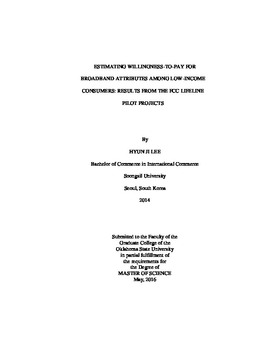| dc.contributor.advisor | Whitacre, Brian | |
| dc.contributor.author | Lee, Hyun Ji | |
| dc.date.accessioned | 2017-02-22T22:15:27Z | |
| dc.date.available | 2017-02-22T22:15:27Z | |
| dc.date.issued | 2016-05-01 | |
| dc.identifier.uri | https://hdl.handle.net/11244/49104 | |
| dc.description.abstract | Recent studies have confirmed that broadband adoption (as opposed to simply having access to broadband infrastructure) is positively linked with economic growth. In light of this, federal policy efforts have switched from focusing mainly on the provision of infrastructure to more explicit adoption-oriented efforts. One of those efforts was the Federal Communications Commissions (FCC?s) Low-income Broadband Lifeline Pilot Projects, which ran from 2012 to 2013. The program worked with 14 private telecommunications firms to subsidize household broadband adoption for low-income households by providing discounted monthly and equipment costs. Low-income households are an important component of the broadband adoption puzzle: between 2003 and 2013, the adoption gap between low-income and high-income households actually increased by 5 percentage points. Further, the most recent data suggests that only half of households making less than $25,000 have a residential connection as compared to 95% of households earning more than $100,000. Thus, if increasing broadband adoption is a policy goal, focusing on low-income households is a good starting point. This paper focuses on three specific FCC Broadband Lifeline Pilot projects (Nexus, Puerto Rico Telephone Company, and National Telecommunications Cooperative Association) that allowed consumers to make choices among different options, such as data allowance, speed, and wireless vs. wired connections. Conditional logit models are used to develop estimates of consumer?s willingness-to-pay for specific broadband attributes. The results indicate that low-income consumers have a preference for smartphone connections (versus aircards) � and that this effect is even more pronounced for those households earning less than $20,000; that low-income consumers have a preference for wired connections (vs. wireless); and that there is evidence that low-income consumers are willing to pay for an extra GB of data each month � but not for the speed of their connection. These results will be useful for the future versions of the Broadband Lifeline Program. In particular, understanding the willingness-to-pay for specific broadband attributes among low-income households will be useful as the federal program defines its baseline. Effective policies built on these results should lessen the adoption gap between different levels of household income and potentially impact the larger economy. | |
| dc.format | application/pdf | |
| dc.language | en_US | |
| dc.rights | Copyright is held by the author who has granted the Oklahoma State University Library the non-exclusive right to share this material in its institutional repository. Contact Digital Library Services at lib-dls@okstate.edu or 405-744-9161 for the permission policy on the use, reproduction or distribution of this material. | |
| dc.title | Estimating Willingness-to-pay for Broadband Attributes among Low-income Consumers: Results from the Fcc Lifeline Pilot Projects | |
| dc.contributor.committeeMember | Sanders, Larry | |
| dc.contributor.committeeMember | Shideler, Dave | |
| osu.filename | Lee_okstate_0664M_14554.pdf | |
| osu.accesstype | Open Access | |
| dc.description.department | Agricultural Economics | |
| dc.type.genre | Thesis | |
| dc.type.material | text | |
